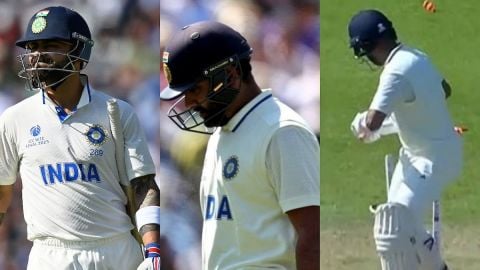WTC Final: India Still Staring Down The Barrel
AUS vs IND WTC Final Day 3: A century partnership for the seventh wicket between Ajinkya Rahane and Shardul Thakur on the third day of the World Test Championship final against Australia saved a follow-on and face for India.

AUS vs IND WTC Final Day 3: A century partnership for the seventh wicket between Ajinkya Rahane and Shardul Thakur on the third day of the World Test Championship final against Australia saved a follow-on and face for India.
But it is still an uphill climb for India to save the Test.
In their second venture, Australia weathered the fire and fury of Mohammed Siraj - which fetched the early wicket of veteran David Warner - and extended their first innings lead of 175 to close to 300. Only a most sensational collapse will bring India into the reckoning.
At draw of stumps on Day 3, Australia were 123/4, leading by 296 runs, with Marnus Labuschagne (41*) and Cameron Green (7*) holding fort.
Trending
With cracks appearing on the pitch which could expand on Saturday, the hottest day of the year forecast so far (28-degree Celsius), Aussie off-spinner Nathan Lyon could come into the frame when India bat in the fourth innings.
Admittedly, though, there was no evidence of assistance to a slow bowler when India's left-arm spinner Ravindra Jadeja operated on the third day.
India may have only one left-handed batsman in all-rounder Jadeja in their ranks - often an off-spinner's bunny. But Lyon could trouble right-handers as well, if the ball really starts turning, not to mention the Australian fast bowlers benefiting from variable bounce.
The Oval has changed unrecognisably since India's maiden appearance here in 1936. Even since the Indians won their first Test in England at this venue in 1971. The only remnant is the original architecture of the old pavilion with its red brick and cement masonry, tiled, sloping roof, two watch towers and a clock in the middle witnessing the action. But the players' dressing rooms are no longer housed within it. Instead, they are located midway up a modern, adjoining construction.
The rest of the ampitheatre is also new, a combination of open or covered terraces or glass-front hospitality suits. One side of the pavilion has extended into a hotel with banqueting facilities. The media arrangement has been moved out of the pavilion as well. It's now in a structure opposite it, at what is known as the Vauxhall End. This shift, though, has much worsened the view of proceedings for print journalists.
The move has gradually metamorphosed the culture and hospitality in the press box. Up to the 1980s, if not beyond, wearing a tie and jacket was conventional attire for all writers and broadcasters (there were no women scribes in yesteryears). Now hardly anyone is so dressed. Even collarless tee-shirts are not objected to! Dhoti-kurta would be amusing, but perfectly acceptable in today's multi-cultural Britain with a Prime Minister of Indian origin.
In earlier decades, wine would begin to flow in the working areas as appetiser for lunch and would continue to be offered for the rest of the day, especially to the late John Arlott, who was the cricket and wine correspondent of The Guardian! Such generosity doesn't exist anymore, nor is there an after play cocktail with the players - which used to be a valuable informal interaction.
The outfield at The Oval was one of the most expansive in the world, but is slightly smaller now to make way for more rows of seats. However, the boundaries are still considerably farther than any Indian ground, with the square fences particularly distant.
Rahane's exquisite cover drives frequently streaked through this extended turf.
Having survived being adjudged leg before to Pat Cummins in the last session of the second day, because it was a no-ball, Rahane briskly posted 60 runs in the morning session, including a six off Cummins to long-on to peg his 50. This helped India realise 100 runs before lunch, notwithstanding the crisis they were in.
But the Mumbai batsman's departure soon after lunch without adding to his score of 89 - square driving uppishly off the backfoot to be caught brilliantly by the tall Cameron Green at gully off the persevering Cummins - disappointed even the minority of Australian supporters dotting the stands, for he certainly deserved three figures, which would have crowned a popular comeback.
Thakur, having been discomfited by awkward bounce at the commencement of his innings, settled down to drive the ball with characteristic power. Indeed, he indicated greater responsibility after Rahane's exit. Yet having completed his 50, he chased a widish delivery from Green to be caught behind.
(Senior cricket writer Ashis Ray is a broadcaster and author of the book 'Cricket World Cup: The Indian Challenge')
